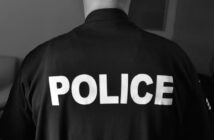In Cincinnati, a robbery suspect fled the scene of a drugstore robbery when a responding police officer spotted him walking down the street.
Before the officer exited his vehicle, the suspect attacked him with a knife and attempted to stab him through the car window.
The suspect was shot and killed by the officer. The confrontation was captured on surveillance video.
The Greater Cincinnati Coalition for the Homeless and Black Lives Matter Cincinnati issued a joint statement saying, “The police officer had his gun drawn as soon as he opened the door. Inevitably this escalated the situation.”
In Los Angeles, police officers responded to a call regarding vandalism in progress. One of the suspects fled. The officers gave chase and an officer-involved shooting occurred. The suspect, a 14-year-old, was killed. A revolver was recovered at the scene. According to police, a witness saw the suspect fire a shot at the pursuing officer.
The department released photographs of the revolver, which were published in news coverage.
Protestors converge and challenge the police department’s version of events. In a Los Angeles Times interview the mother of the 14-year-old said, “It was not right for them to do what they did or kill him. That’s why they are trained as police officers. Not to kill him.”
Most recently, in Milwaukee, police officers making a car stop chased a fleeing suspect. The suspect was shot and killed by a pursuing officer when he refused to drop his weapon. He was in possession a high capacity firearm with 23 rounds in the magazine. An additional 500 rounds of ammunition were found in the vehicle.
Mayor Tom Barret during a press conference said “without a doubt” the suspect was carrying a loaded gun.
The community responded with two days of unrest and significant property damage to businesses. DeRay Mckesson, one of the leaders of the Black Lives Matter movement, tweeted, “I denounce the state violence that led to any protests in the first place.”
In each of these scenarios, there was video – body camera or surveillance footage that supports the officer’s version of events.
But for law enforcement’s harshest critics, that doesn’t seem to be enough.
Body camera footage in the Milwaukee and LAPD shootings has not been publicly released. The investigation is only in the initial stages. The respective departments have released their narratives based on what they’ve observed on the body cam footage.
The surveillance footage in Cincinnati was made public and clearly shows the suspect trying to stab the officer through the car window.
In each of these scenarios the officers are engaging armed suspects. The events unfold almost instantaneously. The officers respond with deadly force when the threat becomes apparent.
It is unrealistic for people to expect police officers to allow themselves to be shot or stabbed in order to justify the use of deadly force. That’s just not going to happen.
It’s crazy to believe that every police officer’s use of deadly force is unwarranted. We live in a society where there are dangerous people, and recently some of those dangerous people have attacked and killed police officers.
At times, it’s the job of every police officer to put themselves in harms way. That does not mean they must allow themselves or others to be harmed before responding.
Given what we know at this point, the officers’ responses in these cases seem to be reasonable. I just hope the loud voices that believe otherwise don’t overwhelm common sense and reasonable expectations.
Joe is a retired Anaheim Police Department captain. You can reach him at jvargas@behindthebadgeoc.com.
 Behind the Badge
Behind the Badge


